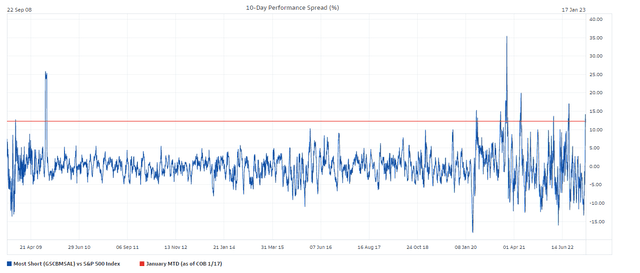[ad_1]
Harbucks/iStock via Getty Images
Nearly Historic Move to Begin the Year:
Anyone who follows the markets knows that the start of the has seen a fairly dramatic rally in assets from the least risky to the riskiest. As of the market close yesterday (January 17th), 10-year US government bonds are up about 3 points, the S&P (SPY) was up ~4% year to date, Nasdaq (QQQ) was up ~5.75% and the Russell 2000 (IWM) was up ~7.14%. As one can see from the indices, the higher the risk and the more speculative the asset, the better the performance. The ARK Innovation Fund (ARKK) was up ~18.5% and Bitcoin (BTC-USD) was up 28.88%.
It should come as no surprise that high-short interest stocks, often the riskiest and most speculative, are doing phenomenally well in this environment. Goldman Sachs (GS) has put together a series of “factor” baskets (stocks that often exhibit the same behavior and might share a trait). Many quantitative trading strategies trade portfolios based on these baskets or on ones that they create themselves. One of the most widely followed baskets is the one that tracks the most heavily shorted stocks in the market. As of last night, this basket has outperformed the S&P (which was up ~4% itself) by 12%. On a trailing 10-day basis (there were only 10 trading days in 2023 after last night), that outperformance was in the 99th percentile going back to September 2008 according to Goldman.

Rolling Outperformance of Most Shorted Baskets over S&P (Goldman Sachs)
This rally would be more believable if the data indicated that people were buying these stocks to get long them rather than buying them as short covers. However, Goldman also reports that US stock single name shorts were covered for 6 straight sessions as of last night.
What starts a short squeeze? It can depend. It seems to me that this one was initially sparked by an interest rate rally driven by people thinking that the Federal Reserve will end its interest rate hikes soon and pivot to cutting rates. I disagree with this notion. While goods inflation is lower largely thanks to lower used car and gasoline prices, services inflation hit a post 1982 high in December. Services inflation is typically stickier than goods.
Whatever the cause of the rate rally, it seems that lower rates made people believe in a return of an accommodative Fed and consequently a risk on environment, where people went dumpster diving. Therefore, it stands to reason that much of the outperformance of high-short interest names like Coinbase (COIN) and MicroStrategy (MSTR), which I have written about recently, was more to short covering rather than true new longs.
The thing about short squeezes, once the people who had to cover their shorts are finished, it’s often difficult to find support for those stocks. This dynamic is particularly acute for companies like COIN that have fundamental problems. That’s why those sharp moves higher shown in the chart above are usually very short-lived.
Risks:
The thing about short squeezes is that they are driven by desperate people. Desperate people attract others who prey on them. In the stock market, these predators often take the form of operators who buy heavily shorted stocks simply to force more short covering. They can create a spiral of purchases whereby the market remains irrational far longer than one can remain solvent. Puts cap downside but have timebombs attached to them. If the market does not normalize before your puts expire, you are out of luck. This short squeeze could endure longer than anyone short the stocks can hold on or too long for put expiry.
Conclusion:
Notwithstanding the warning above, there are signs emerging that some of this rally is fizzling out, at least among the lowest quality/highest short interest stocks. Even if it’s not, it often helps to find high quality names where short interest has risen for some silly reason as a hedge against these baleful market periods. In my case, Signature Bank (SBNY), which I wrote about yesterday, has served me well.
[ad_2]
Image and article originally from seekingalpha.com. Read the original article here.

